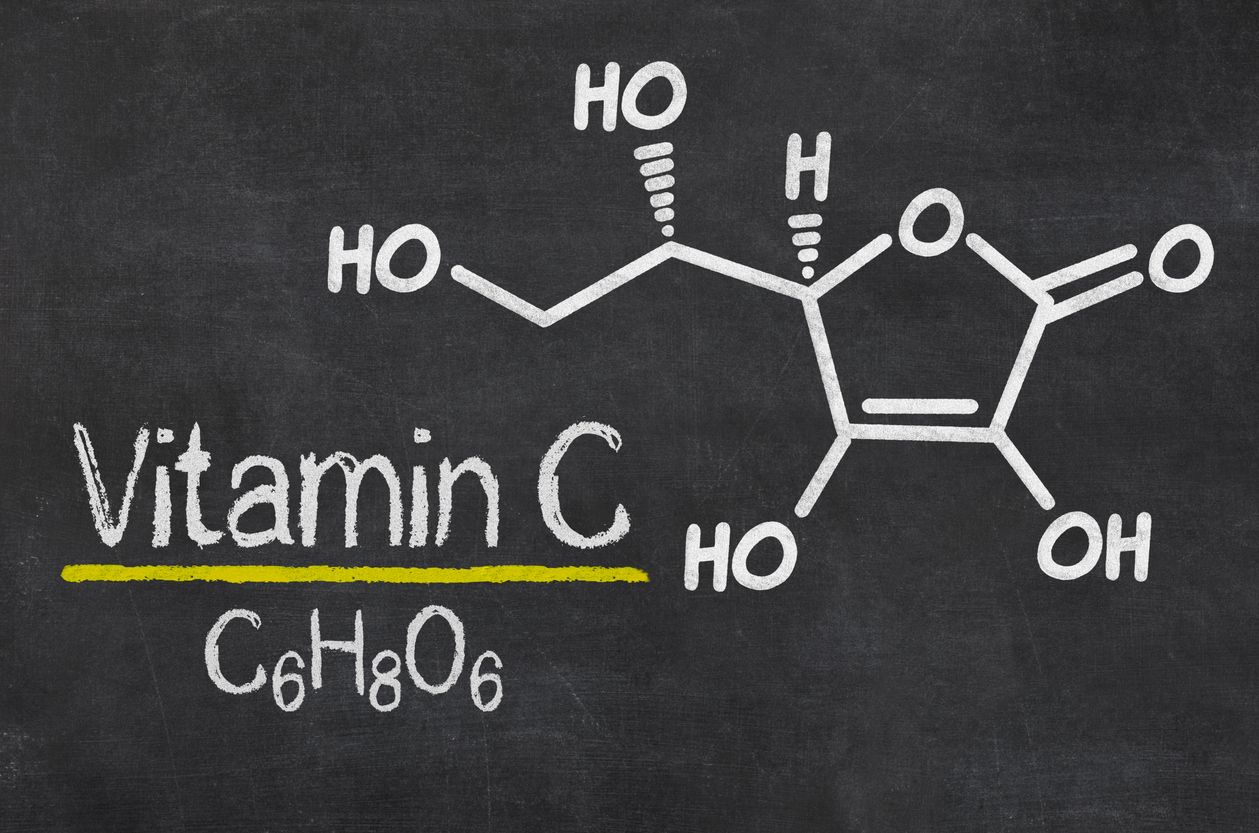Table of Contents
Vitamin C, also referred to as L-ascorbic acid (L-300), is an important part of the body of every healthy person. It promotes the absorption of heavy metals, acts as an antioxidant and creates collagen that is responsible for healthy gums, teeth, bones and blood vessels. While most animals are able to make their own vitamin C, humans depend on its external intake. Either through selected fruits and vegetables or water-soluble powders and tablets.

History of Vitamin C
The consequences of vitamin C deficiency and ways of obtaining it have been known to mankind for centuries. As early as 1700, the sailors knew they would prevent the disease by eating enough oranges and lemons. [1] History remembers many cases of deaths of pirates and castaways who died after a long sea voyage due to a shortage of plant food. Their teeth would fall out and they were suffering with bone fractures, purulent wounds, and crumbling skin. A similar scenario awaited the crew of Jacques Cartier. Their “skins” were saved by an Indian who advised the entire crew to consume tree bark and needles that are rich in vitamin C. Jacques Cartier decided to spread the message of medically beneficious trees to the world. Unfortunately, the doctors did not recognize it- they even mocked it. Officially, vitamin C was discovered much later. First, it was obtained from cabbage and then from peppers in 1928. In 1937, scientist Albert Szent Gyorgiiv even received the Nobel Prize for this achievement. [2]
You might be interested in these products:
Symptoms of vitamin C deficiency
Scurvy is a disease caused by vitamin C deficiency. Its symptoms include subcutaneous bleeding and difficult healing of even small wounds. Bruising and swelling caused by minor injuries, hair loss, toothache, and joint pain can be signs of weakening of blood vessels, connective tissue and bones. These are also the consequences of vitamin C deficiency in the human body. At present, Scurvy is a very rare disease and a daily 10 mg dose of vitamin C is enough to prevent it. However, Scurvy has not disappeared completely because its features may appear as a side effect within some very strict diets. [2]
Other symptoms of vitamin C deficiency in adults:
- loss of vessel elasticity
- subcutaneous bleeding occurs
- bleeding into mucous membranes and joints [2]
Other symptoms of vitamin C deficiency in children:
- restless behavior
- anemia, decreased hemoglobin concentration
- bone disorders and ricket-like condition appears [2]

What is the recommended daily intake of vitamin C?
The recommended intake of vitamin C varies from person to person. It depends, for example, on the age, gender, activity and the like. The so-called PRI (Population Reference Intake) value can help you to estimate at least an approximate amount that your body needs. It is the amount of a given nutrient that should satisfy the needs of all healthy individuals of the population. In the table below, you will learn how PRI differs from person to person. [3]
| AGE | PRI – MEN | PRI – WOMEN |
|---|---|---|
| 7 – 11 month | 20 mg | 20 mg |
| 1 – 3 years | 20 mg | 20 mg |
| 4 – 6 years | 30 mg | 30 mg |
| 7 – 10 years | 45 mg | 45 mg |
| 11 – 14 years | 70 mg | 70 mg |
| 15 – 17 years | 100 mg | 90 mg |
| 18 + years | 110 mg | 95 mg |
| pregnant | – | + 10 mg |
| nursing | – | + 60 mg |
Table 1: Recommended daily intake of vitamin C
According to the AFSSA (French Food Safety Authority), which is now part of ANSES, the recommended intake of vitamin C is slightly higher for smokers. If you smoke cigarettes, you should take 20% more of this vitamin per day than generally recommended. [2-4]
Sources of vitamin C or where to find it?
The best source of vitamin C is fruits and vegetables. Vitamin C is found in most citrus fruits, tomatoes, potatoes, red and green peppers, kiwi, broccoli, strawberries, Brussels sprouts or cantaloupe. Taking the recommended daily dose seems easy. By eating five different pieces of fruit or vegetables, you get more than 200 mg of vitamin C into your body…but…Vitamin C is lost from food during long-term storage and cooking since the effects of ascorbic acid are gradually destroyed by cooking and dissolving in water. The heating of food in the microwave may also reduce the effectiveness of vitamin C. Fortunately, most food sources that contain vitamin C in large quantities (vegetables and fruits) can be eaten raw. [4]
| Food | Serving | Vitamin C |
|---|---|---|
| orange juice | 3/4 cup | 62-93 mg |
| grapefruit juice | 3/4 cup | 62-70 mg |
| Kiwi | 1 piece | 91 mg |
| Orange | 1 piece | 70 mg |
| Grapefruit | 1.2 | 38 mg |
| Strawberries | cup | 85 mg |
| tomato | 1 piece | 16 mg |
| paprika (raw) | 1/2 cup | 95 mg |
| broccoli (cooked) | 1 cup | 101 mg |
| potato (baked) | 1 piece | 17 mg |
| spinach (raw) | 1 cup | 8 mg |
| Papaya | 1 piece | 168 mg |
| Pineapple | 1 cup | 79 mg |
| watermelon | 1 cup | 59 mg |
| cauliflower | 1 cup | 55 mg |
| cabbage | 1 cup | 51 mg |
| Parsley | 1/2 cup | 40 mg |
| Raspberries | 1 cup | 32 mg |
| peas | 1 cup | 20 mg |
| Blueberries | 1 cup | 14 mg |
| cranberries | 1 cup | 13 mg |
Vitamin C contained in selected foods [5]
Since vitamin C is water-soluble, excess intake enters the urine and is excreted from the body. Since it is not stored in the body, its supply must be regularly replenished.

Vitamin C performs many functions in the body
It reduces oxidation, reduces the risk of cardiovascular disease and removes heavy metals from the body. In addition, vitamin C plays a number of other important roles in the human body:
1. Vitamin C is an important antioxidant for the human body because its molecules reduce the formation and activity of oxygen molecules that create an oxidation process in the body. Vitamin C also helps to regenerate vitamin E which, according to recent studies, has the same antioxidant ability as vitamin C.
2. Reduces the likelihood of cardiovascular disease.
3. Vitamin C is an important component in the synthesis of carnitine, dopamine and collagen, which is responsible for skin’s elasticity and firmness and also for the good condition of teeth and gums. It is also involved in the metabolism of iron, copper and bile acids as well as metabolism of folic acid and certain amino acids.
4. Vitamin C also protects the body against heavy metals. A good example is cigarette smoke that contains lead. Vitamin C binds these heavy metals to itself making them easier to be flushed away from the body.
5. Vitamin C plays an important role in the immune system. By stimulating white blood cells, it helps destroy bacteria and secrete the necessary antibodies protecting the immune system. This process prevents the spread of infections.
6. Stimulates interferons, which are an important part of the process of regulating the immune system because they protect the body from viral infections.
7. Scientific studies have shown that vitamin C increases cold resistance. Since most common infectious diseases such as influenza or rhinitis are are caused also due to cold, this finding is a good incentive for citrus fruit consumption.
8. Vitamin C helps prevent nitrosoamines that are formed from nitrates in the acid environment of gastric juices. Nitrosoamines can contribute to the development of colon and rectal cancer. [2]
9. Vitamin C intake delays atrosclerosis and accumulation of cholesterol in blood vessels.
10. It decreases the frequency of seizures in people suffering from asthma.
11. Prevents gastric mucosal metaplasia and subsequent cancer-causing effects [6]
Risk groups with low vitamin C intake
Insufficient intake of vitamin C can be considered to be one that does not meet the recommended daily dose, i.e. 10 mg. Vitamin C taken below the recommended threshold may cause a disease called Moeller-Barlow syndrome in young children, and in older children and adults it is called Scurvy.
If the intake of vitamin C falls below the minimum level of 10 mg / day, the disease will occur in every person after several months.[2]
Smokers and passive smokers
According to scientific studies, smokers have lower plasma, white blood cell and vitamin C levels than non-smokers. This implies that their daily intake of vitamin C should be increased by 35 mg. Decreased levels of the “C” also manifest themselves in people who are involuntarily and regularly exposed to cigarette smoke. [4]

Infants fed with boiled milk
In developed countries, most infants are fed with breast milk or infant formula known as infant milk. In both feeding cases, the baby is given sufficient amount of vitamin C. However, some parents prefer to replace breast milk with cow’s milk. However, in cow’s milk, vitamin C is present in small quantities and is reduced even further by boiling.[7]
People with limited food intake
These may be elderly people who, due to higher age, are unable to prepare food with sufficient amount of vitamin C, mentally ill people or individuals addicted to alcohol or drugs. Since this group of people is most likely to lack a number of other vitamins in addition to vitamin C, their health may be endangered by scurvy, but also by many other diseases. [8]
Individuals with malabsorption and chronic diseases
Some diseases can reduce vitamin C intake absorbed by the body. These are people suffering from intestinal malabsorption, which limits the absorption of important substances from food; cachexia resulting from prolonged nutritional deficiency. People suffering from cancer or advanced kidney disease may also be at risk of vitamin C deficiency. [9] [10]
Vitamin C overdose. Is it even possible?
Vitamin C has a low toxicity and no major cases of damage to the body caused by this vitamin are known. The issues resulting from overdose include: diarrhea, nausea, convulsions and abdominal pain. [8] There are several studies with an unclear conclusion that suggest that excessive use of vitamin C can produce kidney stones, in extreme cases even kidney failure. Other studies have suggested that large doses of vitamin C may mask liver damage and cause headaches, insomnia and stomach irritation. However, the amount of vitamin C, which is not extremely higher than the recommended daily dose, is excluded by the body itself in the form of urine. [2] [11]

Natural vs. artificial vitamin C
On the Internet, one can find a few articles that question the effects of ‘artificial’ vitamin C, which is allegedly inferior to the natural, not so effective, less healthy or even harmful to health. To get to the original sources, where we could learn more about these findings, is in most cases just as impossible as losing 10 kilograms in 7 days. When comparing natural and artificial vitamin C, both are L-ascorbic acid molecules. Vitamin C taken as tablets or powder is the same as vitamin C in fruits or vegetables. The difference is that natural L-ascorbic acid is found in fruit and vegetables complexed with other substances and vitamins. [12]
Through the diet, together with vitamin C we also receive bioflavonoids which support and multiply the effect of acid. However, the effects of bioflavonoids in the natural vitaminc C should not be taken as something that should decide not to use artificial vitamin C, since the observed differences in absorption of artificial and natural vitamin C were not very different. In addition, the natural sources of L-ascorbic acid are not the only ones containing the advantage of bioflavonoids, since there are many nutritional supplements containing them. [12] [13]

In other articles, you can also encounter arguments that most vitamin C supplements are health threatening because genetically modified natural resources have been used to produce them. L-ascorbic acid is obtained from natural sources and, subsequently, in the process of producing nutritional supplements, purified from substances not required therein. In this way, all pollutants are eliminated from natural sources. [12]
Do you take enough vitamin C? Where do you get it from? Share your experience with this vitamin promoting overall health in the comments section. If you liked this article, support it by hitting the “share” button.
[1] Sauberlich, HE. A history of Scurvy and Vitamin C. In Packer, L. and Fuchs, J, eds. Vitamin C in Health and Disease. New York: Marcel Decker Inc., 1997.
[2] Buchanec, J. Vitamín C – Čo o ňom (ne)vieme. Pediatrie pro praxi 1/2005, 2005 – https://www.solen.cz/pdfs/ped/2005/01/04.pdf
[3] Scientific Opinion on Dietary Reference Values for vitamin C – https://efsa.onlinelibrary.wiley.com/doi/pdf/10.2903/j.efsa.2013.3418
[4] Institute of Medicine. Food and Nutrition Board. Dietary Reference Intakes for Vitamin C, Vitamin E, Selenium, and Carotenoids. Washington, DC: National Academy Press, 2000.
[5] World's Healthiest Foods. Vitamin C – https://www.whfoods.com/genpage.php?tname=nutrient
[6] Weber P., Bendich A., Schalch W. Vitamin C and Human Health – A Review of Recent Data Relevant to Human Requirements. Internat. J. Vit. Nutr. Res.,1996.
[7] U.S. Department of Agriculture, Agricultural Research Service. USDA National Nutrient Database for Standard Reference, 2011 – https://www.ars.usda.gov/ba/bhnrc/ndl
[8] Jacob, RA, Sotoudeh, G. Vitamin C Function and is_active in Chronic Disease. Nutr Clin Care, 2002.
[9] Hoffman FA. Micronutrient Requirements of Cancer Patients. Cancer, 1985.
[10] Deicher, R., Hörl, WH. Vitamin C in Chronic Kidney Disease and Hemodialysis Patients. Kidney Blood Press Res, 2003.
[11] Rossoff, TS. Encyclopedia of Clinical Toxicology. The Parthenon Publishing Group. Boca Raton, London,, New York, Washington, 2002.
[12] Šoltés, Ján. Bádateľove bájky o vitamíne C – https://www.lovcisarlatanov.sk/badatelove-bajky-o-vitamine-c
[13] Carr, Anitra C., Vissers, Margreet C. M. Synthetic or Food-Derived Vitamin C – Are They Equally Bioavailable? Nutrients, 2013 – https://www.ncbi.nlm.nih.gov/pmc/articles/PMC3847730/

